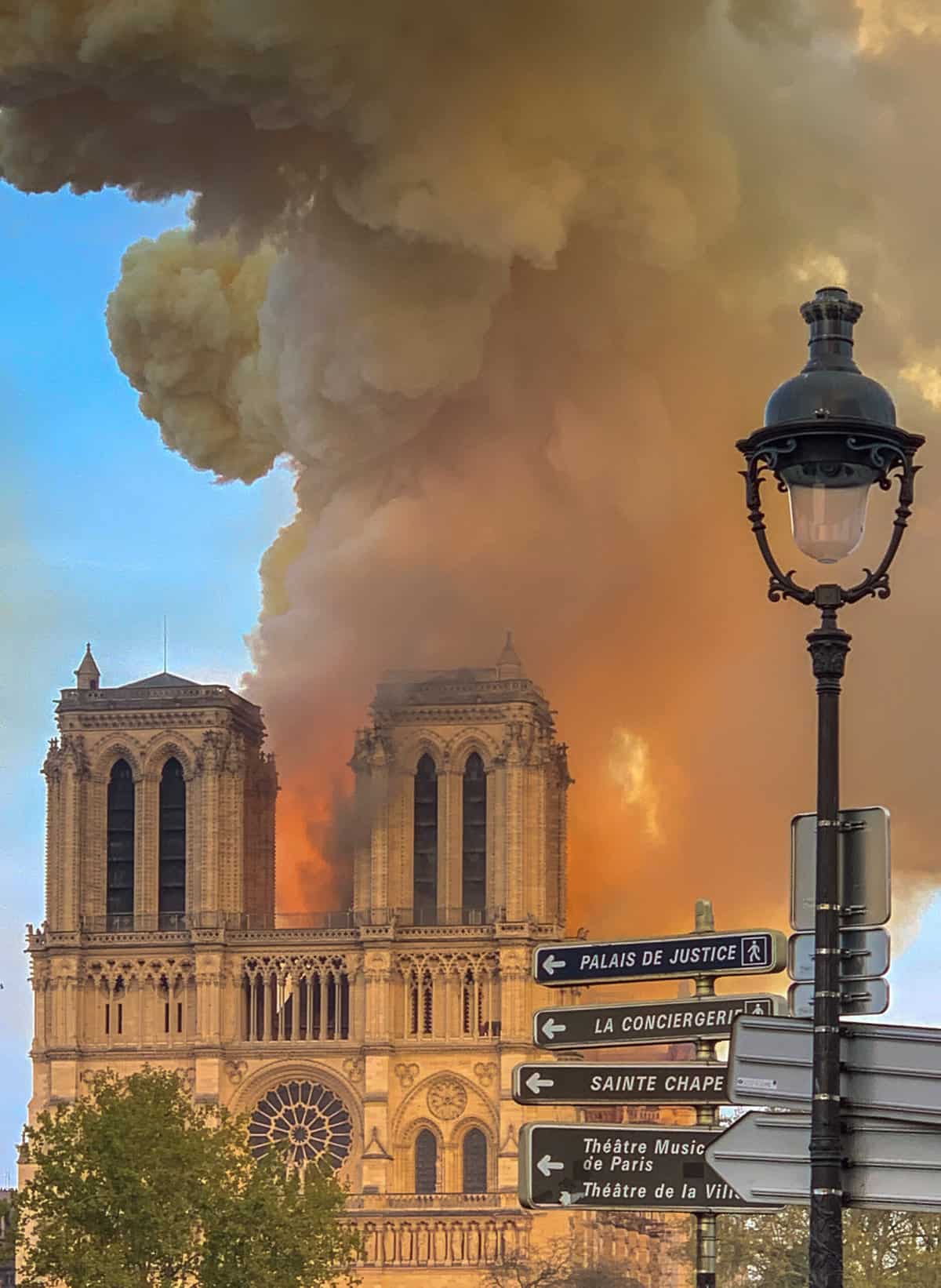
I sat glued to the television screen for hours, transfixed by the plumes of fire and smoke rising to the heavens above Notre Dame de Paris Cathedral. Grief-stricken, I hung on every word the reporters shared of the potential fate of this sacred space. As worshippers and onlookers gathered around the Île de la Cité to watch and pray, I too quietly sat vigil, lifting prayers to God to extinguish the flames’ fury.
Not one to binge-watch news programs, I have tried to comprehend why exactly the burning of Notre Dame affected me so deeply. Watching the cathedral ravaged by fire, my sole response was heaving sorrow for all that was lost.
I am an ardent Francophile. As a teenager, I fell in love with Paris. As a young adult living in the City of Light, I discovered who I wanted to become. On my honeymoon, I shared my Paris with my husband so it would become our Paris. I became a mother while living in Paris. I have celebrated most of my decade-changing birthdays in Paris. Paris has always been my city.
Paris has my heart, and when she hurts, I hurt.
We are told the cathedral will be rebuilt, and now that we see the stone structure remains largely intact, I have no doubt it will. But anyone who knows this sacred space knows it will never be the same. I say this not simply because there are no longer any four-hundred-year-old forests in France capable of producing the enormous oak trees used to construct the wooden beams of the original roof, nor do I say this as a commentary on the capabilities of the skilled artisans.
The artisans who created this house of worship worked in anonymity, that they might bring glory to God rather than to themselves. They did so knowing they would never live long enough to see its completion. Their work was a gift of love, and a gift of faith.
Notre Dame will not be the same because those who first built her believed in the God whose glory was to be celebrated within her walls. This magnificent cathedral, and others of its era, was built by artisans and masons—artists all—who worked in anonymity that they might bring glory to God rather than to themselves. The artisans who created this house of worship did so knowing they would never live long enough to see its completion. Their work was a gift of love, and a gift of faith.
The sheer magnitude of these medieval cathedrals, with their soaring vaulted ceilings, elongated naves, and elevated stained glass windows, pull the worshippers’ eyes upward, reminding us of our place in the world. The believer at once comprehends our smallness before almighty God, and yet our belovedness in the eyes of our Creator.
When we have lost our sense of who we are as a people in relation to our Creator God, how can we possibly build a hallowed space that is meant to bring God glory and not ourselves? Rebuilding Notre Dame is sure to bring glory, but to whom? To the chief architects and artisans? To Paris? To France herself?
I mourn the loss of our purpose behind building these grand sanctuaries. But I also mourn the sacredness of all that was lost within the walls of Notre Dame.
A house of worship allows us to behold the mystery of the Divine. A house of worship as old as Notre Dame de Paris has borne witness to centuries of prayers uttered within its hallowed walls. Prayers of the righteous and the rebellious. Prayers of the devout and the doubter. Prayers of the penitent and the proud. Prayers for rescue, for deliverance, for salvation, for healing. Songs of thanksgiving. Praise for God’s majesty.
Prayers too numerous to count have been laid down thick over the walls, the floors, and the ceilings of this holy sanctuary. The air was unmistakably perfumed of incense, but one who stopped to inhale with the spirit sensed another aroma, the fragrance of prayer. Layers upon layers of prayers and praises to God, whispered over the centuries, have been safely guarded within the embrace of this sanctuary. The air breathes of them.
This sacred fragrance has now been replaced with the odor of burning ash. Have the prayers of the people been burned up like a dry, nine-hundred-year-old forest? Has fire has consumed the offering of these prayers? How can Notre Dame remain a sacred space?
In our humanity we cry out for all that appears to have been destroyed. And yet the final book of Scripture would tell us otherwise. There we read of a time to come—of a magnificent heavenly worship service—where the worshippers hold golden bowls filled with the prayers of God’s people. We are told these prayers are as fragrant as incense and are given as an act of worship to Jesus Christ, the Lamb of God.
Our prayers are never wasted. They can never be burned up or consumed, even in a raging fire. Not a single prayer uttered within the sanctuary of Notre Dame was overlooked and not one will ever be forgotten. In the end of time as we know it, these nine hundred years of prayers will remain and will be gathered in the golden bowls, along with every prayer ever uttered by every one of God’s children anywhere at any time around the globe. No prayer uttered is ever left unheard or disregarded. God’s willingness to hear our prayers is not dependent on our belief but on his goodness.
As flames licked the sky, worshippers gathered in vigil outside their sacred house of prayer. There was no need for hymnal or Bible or prayer book—the prayers and songs of the people were emblazoned on their hearts. From memory, their songs and prayers lifted up to heaven for hours, as they cried out to the God of salvation. It was the first worship service of the new Notre Dame cathedral. A new layer of prayer was laid down even amidst the soaring flames. The rebuilding has already begun.
It was the first worship service of the new Notre Dame cathedral. A new layer of prayer was laid down even amidst the soaring flames. The rebuilding has already begun.
This is Holy Week, the Church’s most solemn seven days when we celebrate the mystery of new life rising from amidst the ashes of death. If the church speaks any message of hope to the broken it is this: where the earthly realm declares death, Jesus declares, “Behold I make all things new!”
Today we grieve the loss of a sacred space that helped us behold the glory, power, and love of God. Eventually, we will return within its walls, faithful and skeptic alike, to seek the Divine. And the One True God will hear each and every prayer we offer.
Our journey into Holy Week leads us to Easter, when we look forward to our ultimate resurrection and life eternal with our God. In one of the final verses in all of Scripture we read these words describing the new earth, “I saw no sanctuary in it, for the Lord God, the Almighty, and the Lamb, are its sanctuary.”
One day, those who love God and trust in his son, Jesus, will stand in God’s presence and share in his glory. And in that final day there will be no need for sanctuary or cathedral, because God, very God, will be in our midst. Immanuel, God with us. He is not dead, behold he is risen!
 A former banker, Bonnie O’Neil spends more time these days with words than with numbers. Her first book is titled My Identity is in Christ, and she writes regularly on her blog This is the Day. Bonnie is an engaging retreat and conference speaker, and she teaches a weekly Bible study at her home church. When not at her desk writing, she can be found raising funds for research to cure type 1 diabetes.
A former banker, Bonnie O’Neil spends more time these days with words than with numbers. Her first book is titled My Identity is in Christ, and she writes regularly on her blog This is the Day. Bonnie is an engaging retreat and conference speaker, and she teaches a weekly Bible study at her home church. When not at her desk writing, she can be found raising funds for research to cure type 1 diabetes.


